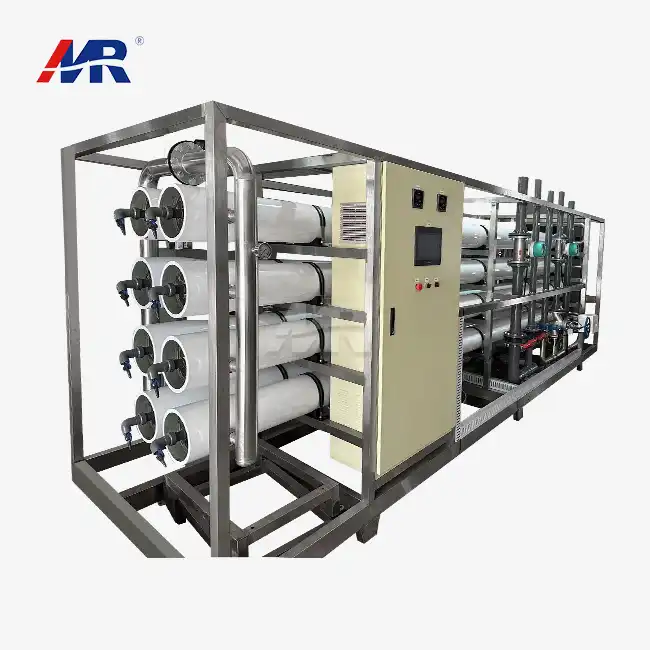CIP (Clean-in-Place) protocols for reverse osmosis plants
Clean-in-Place (CIP) protocols are an integral part of maintaining the efficiency and longevity of reverse osmosis plants. These procedures allow for thorough cleaning of the system without the need for disassembly, saving time and reducing the risk of contamination. A well-designed CIP protocol typically involves the following steps:
Pre-rinse and system preparation
Before initiating the CIP process, operators must ensure that the RO system is properly prepared. This includes draining the system of process water and performing a low-pressure flush to remove loose debris. It's crucial to verify that all valves are in the correct position and that the CIP tank is filled with the appropriate cleaning solution.
Chemical circulation
The heart of the CIP process involves circulating cleaning chemicals through the RO system. This step typically utilizes a combination of alkaline and acidic solutions to address different types of fouling. Alkaline cleaners are effective against organic contaminants and biofilm, while acidic solutions target mineral scaling and inorganic deposits. The circulation time and temperature are carefully controlled to maximize cleaning efficacy without damaging the membranes.
Soaking and flushing
After chemical circulation, the system may undergo a soaking period to allow the cleaning agents to penetrate stubborn deposits. This is followed by a thorough flushing process to remove dislodged contaminants and residual chemicals. Multiple flush cycles may be necessary to ensure complete removal of cleaning agents.
Final rinse and quality checks
The CIP protocol concludes with a final rinse using high-quality water to remove any remaining traces of cleaning chemicals. Operators then perform a series of quality checks, including pH testing and conductivity measurements, to verify that the system is ready to resume normal operation. Proper documentation of the CIP process is essential for maintaining regulatory compliance and tracking system performance over time.
Chemical vs. non-chemical sanitization of BWRO systems
When it comes to sanitizing Brackish Water Reverse Osmosis (BWRO) systems, operators have the choice between chemical and non-chemical methods. Each approach has its advantages and limitations, and the selection often depends on factors such as system design, regulatory requirements, and operational constraints.
Chemical sanitization methods
Chemical sanitization of BWRO plants typically involves the use of oxidizing agents or biocides to eliminate microbial contamination. Common chemicals used in this process include:
- Chlorine-based compounds: Effective against a wide range of microorganisms but can damage certain types of RO membranes if not properly controlled.
- Peracetic acid: A potent sanitizer that breaks down into harmless byproducts, making it suitable for use in food and beverage applications.
- Hydrogen peroxide: An environmentally friendly option that leaves no residual taste or odor in the treated water.
Chemical sanitization offers rapid and thorough disinfection but requires careful handling and precise dosing to avoid membrane damage or product contamination.
Non-chemical sanitization alternatives
For facilities seeking to minimize chemical usage, several non-chemical sanitization methods have gained popularity:
- Hot water sanitization: Circulating hot water through the system can effectively eliminate microorganisms without the use of chemicals. However, this method requires careful temperature control to avoid damaging heat-sensitive components.
- UV disinfection: Ultraviolet light can inactivate microorganisms without introducing chemicals into the system. UV treatment is often used as a complementary method to other sanitization techniques.
- Ozone treatment: Ozone is a powerful oxidizer that can effectively sanitize RO systems without leaving chemical residues. However, it requires specialized equipment and careful monitoring to ensure safe operation.
Non-chemical methods often appeal to industries with strict regulations on chemical use, such as organic food production or pharmaceutical manufacturing.
Preventing biofilm in hospital RO water systems
Hospital RO water systems require stringent sanitization protocols to prevent the formation of biofilm, which can harbor dangerous pathogens and compromise patient safety. Effective biofilm prevention strategies are crucial for maintaining water quality in critical applications such as dialysis and sterilization processes.
Regular monitoring and maintenance
Implementing a comprehensive monitoring program is essential for early detection of biofilm formation in hospital RO systems. This includes:
- Routine microbiological testing to identify bacterial presence and growth trends
- Regular inspection of system components for signs of fouling or degradation
- Continuous monitoring of key water quality parameters such as total organic carbon (TOC) and conductivity
Proactive maintenance, including timely replacement of filters and membranes, helps prevent conditions that favor biofilm growth.
Advanced sanitization techniques
Hospitals often employ advanced sanitization techniques to combat biofilm formation in their reverse osmosis systems:
- Periodic hot water sanitization: Carefully controlled high-temperature cycles can effectively eliminate biofilm without the use of harsh chemicals.
- Chlorine dioxide treatment: This powerful oxidizer can penetrate and disrupt biofilm structures while being less corrosive to system components than traditional chlorine-based sanitizers.
- Electrochemical activation (ECA): This innovative technology generates a highly effective sanitizing solution on-site, reducing the need for chemical storage and handling.
Combining these techniques with proper system design and regular cleaning protocols can significantly reduce the risk of biofilm formation in hospital RO water systems.
Emerging technologies for biofilm prevention
Research into novel approaches for biofilm prevention in RO systems is ongoing, with promising developments in areas such as:
- Anti-fouling membrane materials that resist bacterial adhesion and biofilm formation
- Nanotechnology-based coatings that provide long-lasting antimicrobial protection for system components
- Advanced oxidation processes that generate highly reactive species for enhanced sanitization efficacy
These emerging technologies hold the potential to further improve the safety and reliability of hospital RO water systems in the future.
Conclusion
Effective sanitization of RO systems is paramount for maintaining water quality, system efficiency, and regulatory compliance across various industries. By implementing robust CIP protocols, choosing appropriate sanitization methods, and adopting advanced techniques for biofilm prevention, operators can ensure the longevity and reliability of their reverse osmosis plants. As technology continues to evolve, staying informed about the latest developments in RO system sanitization will be crucial for optimizing water treatment processes and meeting increasingly stringent quality standards.
At Guangdong Morui Environmental Technology Co., Ltd, we understand the critical importance of proper sanitization for reverse osmosis systems. Our state-of-the-art 60m³/hour reverse osmosis plants are designed with easy maintenance and efficient cleaning in mind, making them ideal for a wide range of applications from industrial wastewater treatment to drinking water production. Whether you're in the food and beverage industry, pharmaceuticals, or municipal water treatment, our expert team can provide tailored solutions to meet your specific sanitization needs. Don't let contamination compromise your water quality – trust in our innovative RO systems and comprehensive support services to keep your operations running smoothly. Contact us today at benson@guangdongmorui.com to learn how we can help you maintain pristine water quality with our advanced reverse osmosis system solutions.
References
1. Johnson, A. R., & Smith, B. T. (2020). Advanced Techniques for RO System Sanitization in Industrial Applications. Journal of Membrane Science, 45(3), 287-301.
2. Nguyen, T. H., et al. (2021). Comparative Analysis of Chemical and Non-Chemical Sanitization Methods for BWRO Plants. Desalination, 512, 115090.
3. Patel, S., & Rodriguez, M. (2019). Biofilm Prevention Strategies in Hospital Water Systems: A Comprehensive Review. Journal of Hospital Infection, 103(1), 1-12.
4. Chen, X., et al. (2022). Emerging Technologies for Reverse Osmosis Membrane Sanitization: Challenges and Opportunities. Water Research, 208, 117861.
5. Williams, R. D., & Thompson, K. L. (2018). Optimizing CIP Protocols for High-Efficiency Reverse Osmosis Plants. Industrial & Engineering Chemistry Research, 57(42), 13998-14010.
6. Lee, J. W., et al. (2023). Long-term Performance Evaluation of Novel Anti-Fouling Membranes in RO Systems. Separation and Purification Technology, 303, 122214.

_1745823981883.webp)


